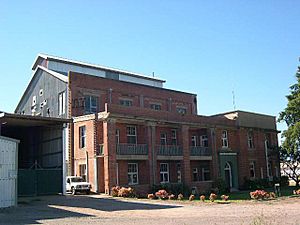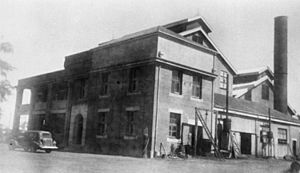Home Hill Powerhouse facts for kids
Quick facts for kids Home Hill Powerhouse |
|
|---|---|

Home Hill Powerhouse
|
|
| Location | First Avenue, Home Hill, Shire of Burdekin, Queensland, Australia |
| Design period | 1919 - 1930s (interwar period) |
| Built | c. 1921 - 1922 |
| Official name: Home Hill Powerhouse, Inkerman Irrigation Area Power House | |
| Type | state heritage (built) |
| Designated | 2 August 2004 |
| Reference no. | 601718 |
| Significant period | 1922 (fabric) 1922-1932, 1932-1947, 1947-1953 (historical) |
| Significant components | office/administration building, machinery/plant/equipment - manufacturing/processing, machinery/plant/equipment - utilities - gas/electricity supply, engine/generator shed/room / power supply |
| Lua error in Module:Location_map at line 420: attempt to index field 'wikibase' (a nil value). | |
The Home Hill Powerhouse is a historic building in Home Hill, Queensland. It was built around 1921-1922. This powerhouse was once the biggest in North Queensland. It supplied electricity to farmers, especially those growing sugar cane, for their irrigation systems. It also powered the town of Home Hill. Today, it is listed on the Queensland Heritage Register because of its important history.
A Powerful History
The Home Hill Powerhouse is a large building made of brick and corrugated iron. It was finished in 1922. It was a key part of the Inkerman Irrigation Area Scheme. This scheme helped farmers get water for their crops. The powerhouse provided electricity for irrigation until 1953.
Early Farming Challenges
The Inkerman area was opened for new settlers in 1911. Many people came to grow sugar cane. However, many farmers had little money or experience. A big drought showed them that they needed a way to water their crops. But most farmers could not afford their own water pumps.
A New Idea for Irrigation
In 1913, local farmers asked the Queensland Government for help. They wanted a shared irrigation system. This system would be like one in New South Wales. It would use a central powerhouse to send electricity to pumps on many farms. An engineer named HEA Eklund visited the area. He found plenty of water underground. He supported the idea of a shared irrigation scheme. This would be the first of its kind in North Queensland.
Eklund thought one powerhouse could serve 135 farms. At first, the cost was too high. But by 1915, more people had settled. The cost was then spread across more farms. Eklund believed the power would be very cheap.
Government Support and Building Begins
In 1915, the Labor government took power in Queensland. They wanted the government to own more businesses. In 1916, they approved the Inkerman irrigation scheme. A special board was set up to manage the project. They started testing well sites and making concrete pipes.
Rising Costs and Delays
Building the powerhouse became more expensive after World War I. Prices went up, and there were shortages and strikes. The cost of the powerhouse rose by 150 percent. Digging wells also became much more expensive. By 1921, the total cost of the scheme was very high.
Opening Day and Early Problems
On May 15, 1922, the Premier, Ted Theodore, officially opened the powerhouse. But the main machine was not yet ready. The powerhouse provided electricity to Home Hill town. It also powered some farms for irrigation. However, it could not run all the pumps at once. Power was given out in turns. At night, there was little demand for power.
In 1923, the government found that the project had cost too much. Many wells were not used. The value of the powerhouse building was cut in half. The scheme was losing money. The Water Supply Department was partly to blame. There was not enough control over costs. Also, running a big powerhouse at night just for town lights was expensive.
Turning Things Around
In 1931, there was a very dry period. The powerhouse had to work 24 hours a day for months. Farmers were given schedules to use power. Meters were installed to measure water and power use. This helped stop waste. For the first time, the powerhouse made a profit.
In 1932, a new government allowed the Inkerman farmers to take over the scheme. The Inkerman Irrigation Board was formed. Farmers became responsible for their own pumps and wells. This local control helped a lot. The Board managed the money well. They even made a profit by supplying power to Home Hill.
Powering the War Effort
During World War II, many soldiers came to North Queensland. The Townsville Power Station struggled to supply enough electricity. The Inkerman Irrigation Board agreed to help. They supplied electricity to Townsville starting in August 1944. This extra power helped the war effort. Selling power also boosted the Irrigation Board's money.
End of an Era
In 1945, a new electricity board was set up in Townsville. In 1946, the Inkerman farmers agreed to let the Townsville board take over. The powerhouse was sold on January 1, 1947.
By 1948, most of the power was flowing from Townsville to Home Hill. The Home Hill Powerhouse kept running for 16 hours a day. But on May 11, 1953, a new power station opened in Townsville. Eight days later, the Home Hill Powerhouse was shut down. For 31 years, its whistle had blown at 8 am, 12 noon, 1 pm, and 5 pm. It helped people in Home Hill know the time for work.
New Life for the Powerhouse
In the mid-1960s, growing rice became important in the area. In 1969, the old Home Hill Powerhouse got a new purpose. The Premier of Queensland, Joh Bjelke-Petersen, opened it as a rice mill.
Many new buildings were added around the powerhouse for the rice milling process. Some parts of the powerhouse were changed inside. Old machinery was removed. More recently, the building has been used to store chemicals for the sugar industry.
What It Looks Like
The former Home Hill Powerhouse is a brick and corrugated iron building on First Avenue in Home Hill. It has two main parts: an office area and the generator house.
The Office Area
The office area is a two-story brick building. It has a central arched doorway with "A.D.1922" (meaning 1922) written above it. This doorway leads to an entrance hall and a concrete staircase.
The western side of the building has a veranda on both floors. Inside, the ground floor has been divided into rooms like a laboratory and storeroom. The walls are painted white. The first floor has two simple rooms.
The eastern side of the ground floor holds the main office for "Pivot Agriculture." It's a large room with reception and office areas. The first floor of this wing used to be offices but is now empty. Some changes have been made inside, like a false ceiling and new windows.
The Generator House
You can reach the former generator building from the entrance hallway. This part of the building is three stories high. It still has some old power plant parts, like steel pipes and fans.
Two large bins for storing rice have been built on the first floor. These bins are supported by concrete pillars. A new corrugated iron warehouse is attached to the back of the building. There is also a long corrugated iron building to the west, which might have been part of the rice factory.
Why It's Important
The Home Hill Powerhouse is listed on the Queensland Heritage Register for several reasons:
- Shows Queensland's History: It helps us understand how irrigation helped the sugar industry grow in North Queensland. It also shows how the government helped develop state-owned businesses.
- A Great Example: It is a good example of a large central powerhouse. It has a brick office building and a connected generator building made of corrugated iron and brick.
- Special to the Community: The powerhouse is very important to the Home Hill community. It first provided power for irrigation, then for homes and shops. The community was involved in building and running the system. For 31 years, its whistle helped regulate working hours in Home Hill.


